Feature: The 'White Sisters' - 100 years of service
Published 2 September 2003
Having spent 16 years in Mombasa, I feel privileged to reflect on our Centenary and our place in the history of the Church in Kenya. It is a tribute to all the sisters who touched its soil: who taught, nursed, cared, and were present in so many creative and life-giving ways. God has surely worked great things and will continue to do so in the lives of those we have touched.
The Missionary Sisters of Our Lady of Africa were founded in 1869 in Algeria, North Africa, by Cardinal Charles Lavigerie, Archbishop of Algiers. Their first Superior General was Mother Marie Salome. They were quickly nicknamed 'White Sisters' because of their white habit which resembled the clothing of Arab women. Cardinal Lavigerie saw the importance of women apostles among women and recognised their vital role in the transformation of society. He wanted his missionaries to be as close to the people as possible: eating their food, knowing and respecting their culture, knowing the language and respecting different faiths.
Our sisters were sent to differing parts of Africa, North Africa first and then West and Central Africa, Tanzania (1894), Uganda (1899), Congo (1895), Malawi (1897),Zambia (1902), Burundi (1906) and Kenya (1907) At present we are 900 sisters from 29 nations.
We are 134 communities - 43 in Africa, 74 in Europe, 15 in Canada, USA and Mexico, with Houses of Formation in Burkina Faso and Kenya. We live in international communities. Our general administration is in Rome. Story begins On April 21, 1907, our first six sisters arrived on the exotic Coast of Mombasa at the request of Bishop Allgeyer, Holy Ghost missionary, then Apostolic Vicar of Zanzibar, to establish the first MSOLA Mission in Mang,u, Thikam Kenya. They bought land on which they planted coffee and fruit trees to provide finance for their new projects. The trees flourished in the ideal climate. The Sisters learned Kikuyu language and customs. The beginnings were hard.
They began to visit people and to teach Catechism. A maternity, dispensary, orphanage and school where basic skills where taught were established. . While education was provided for Africans, Asians and Europeans in Kenya, little was done for children of intercultural families and these children were often marginalized. The sisters started a boarding school for these children which later became Mary Hill Secondary School. In 1976 the two schools were handed over to the Assumption Sisters and Kenyan staff. In Keriko, near Thika, a dispensary was opened and the sisters taught in and headed a Harambee school (Harambee means Working together in Kiswahili). The local community financed the school and we handed full responsibility over to them in 1989. In 1981, Sr Edmonde was made a Kikuyu elder named Nyakio. She remained teaching in another Harambee school for poor children in Thika till 1989.
Other communities were established in Kiambu and Limuru near Nairobi. In Limuru, a school was established for boarders. It was later taken over by the Loreto Sisters. Some of those boarders formed the nucleus of a new local congregation, the Sisters of St Joseph, Bura, now in the Archdiocese of Mombasa. The congregation has now spread far and wide and has remained very close to us, working in education and pastoral fields. In 1955, Archbishop McCarthy of Nairobi entrusted the formation of a new local Kenyan congregation to the MSOLA. They were to be known as the Sisters of the Assumption of the Blessed Virgin Mary of Nairobi. The government of the congregation was handed over in 1970, under the leadership of Sr. Marie Theresa Gacambi and her Council. Today, this vibrant group is no longer a diocesan congregation but is of Pontifical Right. The sisters serve in a number of dioceses in Kenya: in education, medical, pastoral and administration ministries in the service of the underprivileged.
They maintain a special focus on women. Communities have also been established in Jamaica, in the West Indies and the USA. Mombasa 1909 In May 1909, five sisters began to teach on the beautiful island of Mombasa amid temples, mosques and churches surrounded by the sparkling azure blue Indian Ocean and swaying palms. The sisters also started a dispensary and visited the Government hospital. A small farm was started that provided some income. In 1927, a new project was opened in Makupa, Mombasa, where women were taught sewing, cookery, hygiene, childcare, religious instruction and ethics. Classes were also given to Kenyan boys and girls. By 1932 the school catered for 90 children.
The Sisters were involved in many activities but the main focus was The White Sisters Convent School, which is now Star of the Sea School with nursery, primary and secondary sections. Today, it provides education for more than a thousand girls from all faiths. In 1975, the Sisters handed over the primary school to the Sisters of St Joseph of Mombasa. The Nursery School also was given to them in 1976. Finally the Secondary School became a High School and was handed over in the early eighties. The school was famous for its music and high educational standards. Being open to all faiths promoted dialogue between faiths, especially Islam, and created precious contact with women and families which has deepened over the years. Our Srs. Thecla de Souza, Cecilia Commissariart, Vivian de Souza, Edith Quadros, Filo Pereira and Daphne Alphonso are past pupils. The family of Sr Zita Cardozo, originally from Zanzibar, settled in Mombasa, and it was from there that she entered the MSOLA. Always reaching out
There was an urgent need for education for young Kenyans. The sisters recognized this need and in 1959 opened Marycliff Primary School, Tudor, a poorer part of the island. It was handed over in 1970 by Sr. Vivien de Souza to lay Kenyan leadership. Women's groups were founded in a number of areas. Savings and credit unions were also set up. On Mombasa Island there were 15 secondary schools in the 1970s, so a hostel for girls was opened to assist those who needed accommodation while in school. Sr Zita Cardozo worked on this ecumenical project. The hostel is now Mama Ngina Secondary School. Religious Education became a priority in the 80's. As we had handed over the schools, a Religious Education Centre was established by Sr Marguerite Gemme and her team. The centre saw more than 800 teachers go through the Religious Education Awareness Programme (REAP) as well as the many and varied projects it offered.
In the 80's a new project for 'Women in Distress', SOLWODI, was set up by Sr Lea Ackerman. It has now grown into an international body based in Germany but still has a centre in Mombasa. This has become even more essential now with the era of human trafficking and has been further developed to provide assistance for the children of women in distress.
In 1990, Star of the Sea Convent was handed over to the Archdiocese of Mombasa,. A new community was established in Changamwe, some 10 kilometres off the island. AIDS ministry, together with building of Small Christian Communities and the youth formed a priority. One of the Sisters, Sr Maggi Kennedy, developed the Social Communications Centre.
The Changamwe Community was handed over to the Sisters of Mary the Mother of God in 2003 In 1975, a House of Prayer Community was established in Kisii Diocese in the south west of Kenya. In 1979 three members of the community died in a tragic road accident. The community was closed in the early 90's. Other projects began in Eldoret for education and youth. In Eldoret also three sisters pioneered Mitume Centre which trained catechists. Again these projects were handed over to African staff. Sr Tini Holscher pioneered the work of the Association of the Sisterhoods of Kenya (AOSK) in the area of renewal and formation after Vatican II. She was at the heart of the Tumaini (Hope) Centre which has now grown into a new Centre: Chemi Ya Uzima (Swahili for Fountain of Life). Over the years MSOLA, have been involved in the work of the AOSK, together with Association for Consecrated Women in Eastern and Central Africa (ACWECA). This working together with different congregations is very much part of our tradition. We have formed 22 different local congregations together with a lay Institute for Widows in Africa, which we still support.
A new thrust Moving away from institutions gave us a new thrust for the 'option for the poor'. Communities opened in various areas in Nairobi: Kangemi, Eastleigh, Lang'ata, and Kibera, a slum of some 800,000 people. Dollicraft at St Joseph the Worker Parish, Kangemi, Nairobi, facilitated by Sr Cecile Peloquin, became an income- generating project for more than 50 women. The project involved making African dolls of the different ethnic groups in Kenya. They became extremely popular with tourists. The group also made Church vestments in African fabric, which helped encourage enculturation. At St Michael's Parish, Lang'ata, run by the Guadalupe Fathers from Mexico our sisters pioneered the work of the Small Christian Communities. The sisters were key in this process just as they had been in Kangemi with the Jesuit Fathers.
In Eastleigh, East Nairobi, the sisters worked with the White Fathers (Missionaries of Africa) in Mathare valley, a place of appalling poverty. Sisters tried to raise people's dignitym with projects especially for women. Others in Nairobi have been involved with diverse ministries since the 1980s, such as ministries for those with physical disabilities, counselling cancer patients, HIV/Aids ministry, and education. African Province today Nairobi is the centre for the four regions of the African Province, We are present in 15 countries. Sr Jocelyn Morin is our Provincial. At present, in Kenya, we are based in Nairobi, in four communities, Sr Christine Bahati-Safi teaches in Laini Saba School, Kibera.
Other sisters are concerned with justice and peace work and interfaith dialogue. South B welcomes students and there is an involvement in Mukuru Primary School for children from the slums and an orphanage. South C Community acts as a missionary/vocational community, providing a contact point for those interested in our way of life. To express a 100 years in a few words is impossible. We can only say thank you to those who planted the seeds and those who continue to plant, water and reap. We are proud to have been part of this vibrant Kenyan Church.
Hongera wote!
(Congratulations to you all!)





















